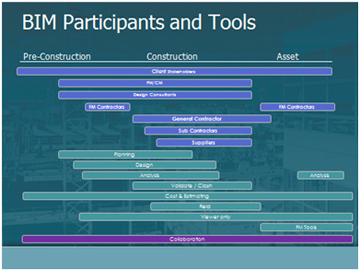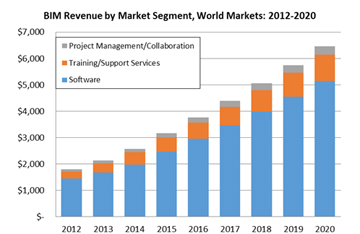
|
www.agc.org Contact Us Archives/Subscribe Advertise IT Forum IT Forum Steering Committee |
BIM and the Power of CollaborationThe Future is Now
BY ROB HUMPHREYS
Construction firms in North America and several other countries are moving quickly to understand the power of BIM for unparalleled project collaboration. For companies who have been using BIM and collaboration technology for a longer period of time, the tools have proven to be unequivocally successful regarding the quality of the results produced. BIM has proven time and again to drive down costs and make the estimation process more accurate for building owners and financiers. According to an article by Pike Research, "When it comes to building asset owners, BIM helps facilitate more visibility and interaction in the overall design/build process for the owners of a building, enabling them to take a more active role in determining the final outcome of capital-intensive projects."1
In fact, the power of BIM reaches all project parties, delivering benefits like no other current collaboration tool.
SO WHAT IS BIM?
With all the talk about BIM, there’s often some confusion. Some think BIM is 3D design software while others think of it primarily as the 3D model of a building that is generated by the software. Yet there are other curious folks who have dived deeper into research and understand that BIM goes beyond these simple definitions and can actually drive a whole new process for construction. The truth is, they’re all right - BIM is all of these things and more. Here’s a brief summary:
BIM describes the process of designing a building collaboratively using one coherent system of computer models rather than separate sets of drawings. The models become shared knowledge resources to support decision making about a facility from earliest conceptual stages, through design and construction and then through its operational life and eventual demolition.
It offers enormous gains in cost and time savings, much greater accuracy in estimation, and the avoidance of error, alterations and rework due to information loss. BIM offers a way for people to collaborate, to share and develop a single integrated model. The whole building, bridge or road is constructed virtually with everyone viewing the exact-same data.
PLAYERS, PARTICIPANTS AND TOOLS
From pre-construction to final asset and even into lifecycle management, BIM tools play a large part in successful management and information sharing throughout the entire project spectrum. BIM also allows a large swath of roles within the contractor, subcontractor, owner and supplier arenas (plus others) to share and view vital project documents. Regarding lifecycle management, the value of BIM extends beyond design and construction and into the post-construction realm by delivering information that the owner/operator can use for facilities management, operations, maintenance, refurbishment or eventual demolition. This simple chart shows the different people and processes that benefit from BIM collaboration across the project timeline.

BIG BENEFITS Since we’re talking about the interested parties involved in a project, let’s take a look at the benefits everyone receives by utilizing BIM tools. Like no other technology on the market today, the benefits that BIM provides touch everyone involved on a project. Specific examples of what BIM can do for the different people and roles include:
THERE’S EVEN MORE The benefits listed above are some of the direct benefits that BIM provides. In addition to these benefits, there’s also what’s often referred to as the "human side" to BIM. BIM drives a new process into an organization that encourages the project team (owners, architects, engineers, general contractor, subcontractors, suppliers, etc.) to work together for optimal performance on a project. This instills pride in workmanship across all parties and maintains accountability for missteps.
Then there are the obvious marketing benefits. Simply put, owners that understand the benefits of BIM are more likely to choose contractors that use BIM tools and a collaborative construction process because then everyone is on the same page regarding quality of the built asset (the project).
ADOPTION AND GLOBAL REACH
As previously mentioned, BIM is exploding in usage around the world. In some countries, it is becoming a requirement to have BIM collaboration documentation on certain large-scale projects. The reasons are simple – collaboration tools ensure accountability among all parties, emphasizes uniform quality for the final product and leaves no one in the dark about change orders and shifts in scope. Here are a few basic facts about BIM adoption and implementation as presented in a report by McGraw-Hill Construction.2
There are lots of statistics available about the projected growth and adoption of BIM over the next few years. A quick Google search will deliver plenty of graphs and charts that show some promising numbers for the future. The following statistics indicate that BIM collaboration tools will be necessary for contractors to compete over the next 10 years.
The demand/market for BIM software is evolving rapidly and BIM software and services look to reach 6.5 billion in sales by 2020. There’s clearly a massive emerging new market for tools to support the new BIM processes associated with collaboration software that are being implemented at an unprecedented rate within contractor organizations. Perhaps most interesting is that the public sector, private sector and even the facilities management sectors are showing increasing interest in deploying BIM at their firms. Architectural and structural firms are also looking into the benefits of BIM. The breakdown shown on the two charts below represents the growth by market segment and regions of the highest growth.
Software represents 75-80 percent of the overall market.
  THE MARKET DEMANDS IT According to Pike Research, "Building efficiency is at the forefront of conversations everywhere regarding energy and water use, waste, and cost of operations. As energy conservation and carbon emissions become increasingly important on a global basis, the adoption of BIM tools and practices will become a higher priority, since it can significantly affect the efficient use of valuable and scarce resources."3 It’s also becoming clear to contractors that being an early adopter of BIM tools can give them a distinct competitive advantage over their competitors. In fact, BIM has been identified by many as the solution to the inefficiencies that have existed within their companies and the industry at large for ages, providing further proof that BIM adoption will become a necessity for competing effectively in the market. Like any new technology or enterprise-wide software solution, there is still some resistance to the adoption of BIM due to concerns about changing the way their teams work. However, as it’s been proven time and again, the most competitive industry leaders reap the benefits of early adoption. The companies that choose to "wait and see" may begin a frustrating cycle of catching up while the early adopters begin seeing a return on their investment.
THE FUTURE
Numerous publications have declared that BIM-engaged contractors are positioned to become industry leaders. The trend toward BIM and online collaboration tools is expected to continue, particularly with the rise of integrated project delivery models and the inclusion of all the respective skill sets involved in a project. It’s becoming clear that contractors who are highly engaged with BIM will emerge as the prominent leaders on most of the major projects in the construction industry. Are you on board?
Rob Humphreys is the vice president of product management for Viewpoint Construction Software. Over his more than 28 years focused on the construction software market, he has developed a keen sense for what customers need from their software and how to stay current in a climate of rapid change.
1 Pike Research, Tom Machinchick, Eric Bloom Building Information Modeling Q2, 2012
2 McGraw-Hill Construction The Business Value of BIM in North America: Multi-year Analysis and User Ratings (2007 – 2012)
3 Pike Research, Tom Machinchick, Eric Bloom Building Information Modeling Q2, 2012
|

2300 Wilson Boulevard, Suite 300 · Arlington, VA 22201 · 703-548-3118 (phone) · 703-548-3119 (fax) · www.agc.org
About AGC | Advocacy | Industry Topics | Programs and Events | Career Development | News & Media
© Copyright 2025 The Associated General Contractors of America. All rights reserved.


